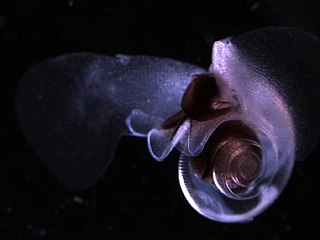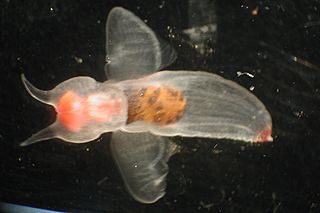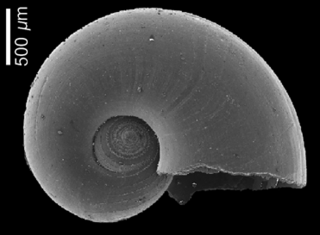
The Thecosomata, or sea butterflies, are a taxonomic suborder of small, pelagic, free-swimming sea snails known as holoplanktonic opisthobranch gastropod mollusks, in the order Pteropoda. Most pteropods have some form of calcified shell, although it is often very light, even translucent.

Sea angels are a large group of small free-swimming sea slugs, classified into six separate families. They are pelagic opisthobranchs in the clade Gymnosomata within the larger mollusc clade Heterobranchia. Sea angels were previously considered to be pteropods.

Limacina is a genus of swimming predatory sea snails commonly known as sea butterflies in the family Limacinidae. This genus contains some of the world's most abundant gastropod species.

The superfamily Cavolinioidea is the most speciose group of sea butterflies. They belong to the suborder Euthecosomata.

Littorinimorpha is a large order of snails, gastropods, consisting primarily of sea snails, but also including some freshwater snails and land snails.

Ceolodiscus is a genus in the gastropod family Euomphalidae from the Lower and Middle Jurassic of Europe, mostly on Germany, France and United Kingdom. Other posible records include specimens from Hungary of Earliest Jurassic (Hettangian) age. As well there are specimens from Switzerland of Middle Jurassic age. It is the only genus in the monotypic family Coelodiscidae. The genus is usually allied with modern Pterotracheoidea, based mostly on it´s resemblance with modern Atlanta larvae, yet it differs by lacking extant family affiliations. This genus is linked with the Toarcian Oceanic Anoxic Event, that likely triggered it´s evolution.

Atlantidae is a family of sea snails, holoplanktonic gastropod molluscs in the clade Littorinimorpha.

Carinariidae, known by the common name "heteropods" like their relatives in the Pterotracheoidea, is a taxonomic family of swimming or floating sea snails, pelagic marine gastropod molluscs in the clade Littorinimorpha.

Carinaria is a genus of medium-sized floating sea snails, pelagic gastropod molluscs in the family Carinariidae.

Pterotracheidae is a family of medium-sized to large floating sea snails, pelagic gastropod molluscs. They are in the superfamily Pterotracheoidea along with two other similar pelagic families, the Atlantidae and the Carinariidae.

Vetigastropoda is a major taxonomic group of sea snails, marine gastropod mollusks that form a very ancient lineage. Taxonomically the Vetigastropoda are sometimes treated as an order, although they are treated as an unranked clade in Bouchet and Rocroi, 2005.

Cymbulioidea is a taxonomic superfamily of pelagic "sea butterflies", one group of swimming sea snails. They are holoplanktonic opisthobranch gastropod molluscs in the clade Thecosomata.

Atlanta echinogyra is a species of sea snail, a holoplanktonic marine gastropod mollusk in the family Atlantidae.

Oxygyrus keraudrenii is a species of sea snail, a holoplanktonic marine gastropod mollusk in the family Atlantidae.

Protatlanta souleyeti is a species of sea snail, a holoplanktonic marine gastropod mollusk in the family Atlantidae.

Atlanta is a genus of pelagic marine gastropod molluscs in the family Atlantidae.

Protatlanta rotundata is an extinct species of sea snail, a holoplanktonic marine gastropod mollusk in the family Atlantidae.
Limacina retroversa is a distinct species of swimming planktonic gastropods, belonging to a group of predatory sea snails known as sea butterflies (Thecosomata). The name Limacina retroversa describes the unique morphology of this sea snail, including its slug-like body and coiled, backwards-turning shell. They are typically found in the epipelagic zone of cold, polar waters, but can be found worldwide, in any ocean. L. retroversa are currently under threat, as their numbers are decreasing due to rising global carbon levels and other human-caused climate threats.

Carinaria cristata, commonly known as the glassy nautilus, is a species of pelagic marine gastropod mollusc in the family Carinariidae. It is found in the Pacific Ocean and is described as being holoplanktonic, because it spends its entire life as part of the plankton. It was first described by Carl Linnaeus in 1767. Its fragile shell was much prized by early conchologists for their collections, being so rare that it was said to be worth more than its weight in gold.
Carinaria galea, common name the helmeted carinaria, is a species of sea snail, a marine pelagic marine gastropod mollusc in the family Carinariidae. It was first described in 1835 by William Henry Benson, an amateur malacologist in the Bengal Civil Service.















